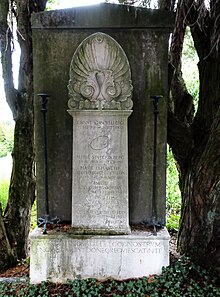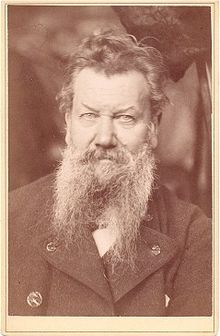Ernst Stückelberg
Ernst Stückelberg (baptismal name Johann Ernst Melchior Stickelberger ; * February 21, 1831 in Basel ; † September 14, 1903 there ) was a Swiss painter , one of the most popular of his time.
Life
Ernst Stickelberg came from the Stickelberger patrician family in Basel . His father was the merchant Emanuel Stickelberger, whose second wife was his mother Susanne, Melchior Berri's sister . He changed the family name Stickelberger , which had been used since the 14th century, to Stückelberg. After the early death of his father in 1833, Melchior Berri took care of his education. Stickelberger received his first drawing lessons from Hieronymus Hess and Ludwig Adam Kelterborn (1849–1850) when he was still at school .
After leaving school, he completed an apprenticeship with the portraitist Johann Friedrich Dietler in Bern. In 1850, Stückelberg studied in Antwerp at the academy with Gustave Wappers . The works created there are kept in the collection of the Basler Kunstverein . He then traveled to Paris to study and had a. a. Contact Amsel Feuerbach .
In 1853, Stückelberg went to Munich, where he took lessons from Moritz von Schwind for a short time . From 1854 to 1856 he studied at the art academy in Munich . One of his most famous historical pictures was taken there in 1855. Melchtal returns to his father, who was blinded at Landenberg's behest, the Vogts von Sarnen .
In 1856, Stückelberg traveled to Florence for five months to live and work in Rome from 1857 to 1859 . There he lived on Via San Carlo alle Quattro Fontane No. 53, with Teresa Reinhart, the daughter of Johann Christian Reinhart .
In Rome he met his old artist friends Arnold Böcklin , Franz-Dreber , Rudolf Henneberg and Anselm Feuerbach and learned a. a. Caspar von Zumbusch , Julius Moser and Victor von Meyenburg know. In the summer months he painted in various places outside Rome, such as Vicovaro , Cervara and Anticoli-Corrado . Stückelberg was the first painter who settled down to work in the mountain village in 1858. Later a painters colony developed in this place.
In 1860, Stückelberg moved to Zurich, where he made friends with Rudolf Koller , Gottfried Keller , Friedrich Theodor Vischer and Conrad Ferdinand Meyer . From 1862 he traveled to Italy again and fell ill there. First he returned to Ticino, then he went to St. Moritz to relax, and finally to Zandvoord for another spa stay .
Returning to Basel in 1866 he married the daughter of the Mulhouse merchant Eduard Brüstlein-du Pasquier, Maria Elisabeth Brüstlein (1842–1927), with whom he had seven children. Her honeymoon took her to Naples , Pompeii and Capri . Back in Basel, he exhibited the pictures he took there in the city casino .
From 1867 to 1926 Stückelberg taught art history at the trade school in Basel. In 1860 Jacob Burckhardt asked him to draw up a draft for the planned St. Jakobs monument in Basel, which was approved by the responsible city council commission. The Rome-based sculptor Ferdinand Schlöth , who had been awarded first prize for his design in the competition held a year earlier, was not prepared to carry out a design made by someone else, although he maintained a friendly relationship with Stückelberg during his stay in Rome would have.
Teaching requests from various academies followed, but he refused. In 1871, Stückelberg bought the “Erismannshof” in Basel and from 1873 to 1874 he painted it with frescoes .
In 1877 he painted the mural The Awakening of Art in the stairwell of the Basler Kunsthalle . He also won the competition to decorate the Tell Chapel on Lake Uri . For this he moved into a studio in the old Zwingenherrenturm in Bürglen . The mural was inaugurated on June 24, 1883 and Stückelberg received the title of honorary doctor from the University of Zurich .
In 1888, Stückelberg stayed again in Rome, Capri and Anticoli-Corrado.

In 1882, Stückelberg's mother died. The death of his sister in 1890 led to a five-year interruption in Stückelberg's work. In 1901, on his 70th birthday, an anniversary exhibition took place in the Kunsthalle Basel , at which Johann Rudolf Rahn gave a speech as a representative of the University of Zurich. In the same year, the first studies of frescoes for the chapel in Hohlen Gasse were carried out , but they were never carried out. Stückelberg showed his work at national and international exhibitions and received numerous awards and honors.
In parallel to the work on the Tell Chapel, in 1883, Stückelberg painted one of his best-known works on behalf of Peter Conradin von Planta: The Last Knight of Hohenrätien plunges into the abyss of the Via Mala , in which Stückelberg takes up the legend of the last knight of Hohenrätien Castle above Thusis . The picture hangs today in the Bündner Kunstmuseum .
In 1873, Stückelberg became a knight of the Franz Joseph Order . His stage name Stückelberg , which he adopted in 1881, was officially declared a legal name by the government council of the Canton of Basel-Stadt in 1885 .
One daughter of Stückelberg was the painter Marie Stückelberg (1869-1917) and Gertrud Stückelberg (1871-1944). One son was the historian Ernst Alfred Stückelberg , and a grandson of the mathematician Ernst Carl Gerlach Stückelberg . Stückelberg found his final resting place in the Wolfgottesacker cemetery .
plant
Stückelberg's popular art, which is subject to a strictly hierarchical order of genre , portrait and landscape painting , was described as conservative , striking and close to the people. His most famous works include the frescoes in the Tell Chapel on Lake Uri and the girl with the lizard from 1884 . The latter is used in Bernard Schlink's volume of stories , escapes from love , even if it is ascribed to a nonexistent painter named René Dalmann.
An example of a small painting he created is Villa Mignonne, St. Raphael (12 by 22 cm, painted with oil on wood). It was created in 1896 and shows a seascape. Stückelberg painted hundreds of these so-called boards ; He always carried some wooden boards of the same size with him with his painting utensils.
literature
- Albert Geßler: Ernst Stückelberg , Vol. 5, 1901, pp. 177-183
- Albert Geßler: Ernst Stückelberg. In: Basler Jahrbuch 1904 , pp. 1–160.
Web links
- Regine Helbling: Stückelberg, Ernst. In: Sikart
- Tapan Bhattacharya: Stückelberg, Ernst. In: Historical Lexicon of Switzerland .
- Literature by and about Ernst Stückelberg in the catalog of the German National Library
- Ernst Stückelberg In: Stroux.org
- Ernst Stückelberg In: E-Periodica
- Ernst Stückelberg In: Swissbib
Individual evidence
- ^ Academy of Fine Arts Munich: 1854, register book. Retrieved November 29, 2019 .
- ↑ Stefan Hess / Tomas Lochman (eds.), Classical beauty and patriotic heroism. The Basel sculptor Ferdinand Schlöth (1818–1891) , Basel 2004, pp. 46, 48.
- ↑ Marie Stückelberg (1869–1917)
| personal data | |
|---|---|
| SURNAME | Stückelberg, Ernst |
| ALTERNATIVE NAMES | Stickelberger, Johann Melchior Ernst (full name) |
| BRIEF DESCRIPTION | Swiss painter |
| DATE OF BIRTH | February 21, 1831 |
| PLACE OF BIRTH | Basel |
| DATE OF DEATH | September 14, 1903 |
| Place of death | Basel |






